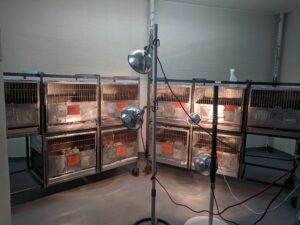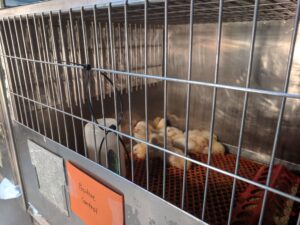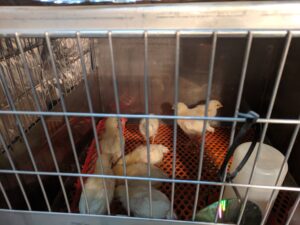Final report for GNC18-259
Project Information
Avian pathogenic E. coli (APEC), an extra-intestinal pathogenic E. coli (ExPEC), is one of the most common bacterial pathogens of poultry and can be potentially transmitted to humans through consumption of contaminated poultry products. It causes multiple extra-intestinal diseases in poultry, collectively called as avian colibacillosis, which results in high morbidity and mortality (up to 20%), meat and eggs production losses, and increased condemnation of carcasses at slaughter (up to 45%), thus poses significant threat to global poultry production and food security as well as sustainable animal agriculture worldwide. Currently, APEC infections in poultry are controlled by antibiotics medication and vaccination; however, the emergence of multi-drug resistant APEC strains worldwide limits the antibiotics use and vaccines are unable to provide sufficient protection against diverse APEC serotypes. Further, Food and Drug Administration (FDA) in the United States has recommended the voluntarily phasing out the production uses of medically important antibiotics in food-producing animals, with the goal of reducing the selection pressure and the emergence of resistant bacteria (Guidance for Industry, #209,
#213). However, limiting on-farm use of antibiotics could significantly increase animal morbidity and mortality and compromise production efficiency and food security. Therefore, it is critical to replace antibiotics with alternatives that effectively mitigate pathogens on farm for sustainable and safe food production. Towards this end, by conducting multiple in vitro assays, we have identified two probiotics in our lab with strong antimicrobial activity against APEC. We hypothesized that probiotics can effectively prevent APEC infections in poultry, thus provide alternate strategy to control APEC and reduce the reliance on antibiotics. Furthermore, we have prepared probiotics microcapsules using chitosan-alginate microencapsulation technology; encapsulation prolongs the action of probiotics, thereby facilitate efficient delivery of the probiotics to chickens. Here, we propose to test the efficacy of identified probiotics to prevent APEC infections in poultry both in controlled laboratory condition as well as in field conditions. This study will help to develop as well as farmers adoption of non-antibiotic control method for effective management of APEC infections in poultry farms. Through effective control of infections, animal health can be promoted and losses can be minimized ensuring food security. Moreover, public health can be safeguarded by producing safe and wholesome food.
This study will address the issue of antibiotic resistance and focused on developing antibiotic-independent control method.
Learning outcomes: we expect that farmers will increase their knowledge about poultry diseases, antibiotics, antibiotic resistance, and potential non-antibiotic alternatives. The awareness level on prudent use of antibiotics, food security, and food safety is expected to increase. The positive attitude of farmers to enhance the food animal production along with production of safe and wholesome food is expected to nurture. In addition, the husbandry skills of farmers to rear healthy food animals are expected to enhance.
Action outcomes: we expect that farmers will adopt probiotics based control method to control APEC and other poultry associated diseases on their farms. Also, the farmers dependency on antibiotics to control poultry diseases is expected to shift towards possible non-antibiotic alternatives.
Cooperators
Research

Objective 1: Conduct preliminary clinical trial to measure the efficacy of probiotic and probiotic microcapsules to prevent APEC infection in chickens.
Methods: We tested the efficacy of two probiotics, Lactobacillus rhamnosus GG (LGG) and Bifidobacterium lactis Bb12 (Bb12), against APEC infection in chickens. The probiotics were tested either as free bacteria, encapsulated as microcapsules, or in combinations (1:1 of either free or microencapsulated bacteria). Two-weeks-old specific pathogen free (SPF) layer chickens (Leghorns) were used. A total of 8 groups (10 chickens/group) were allocated; G-1: APEC infected and treated with LGG, G-2: APEC infected and treated with Bb12, G-3: APEC infected and treated with LGG and Bb12 combination, G-4: APEC infected and treated with LGG microcapsules, G-5: APEC infected and treated with Bb12 microcapsules, G-6: APEC infected and treated with LGG and Bb12 microcapsules combination, G-7: APEC infected but non-treated (PC group; positive control), and G-8: non-infected and non-treated (NC group; negative control). Probiotics, their microcapsules, and the combinations were orally administered (200 μL) to chickens (108 CFU/chicken) once daily for 12 days (from day 1 to day 12). On day 6, chickens were infected orally with rifampicin resistant APEC O78 (7.5×107 CFU/chicken). Before the infection, rectal swabs (n=2/group) were collected randomly from each group to confirm the absence of APEC in chickens. The clinical signs of chickens were recorded until 7 days post-infection. On day 14, chickens were euthanized, necropsied, and internal organs (cecum, liver, and heart) were collected for quantitation of APEC load by plating on MacConkey agar plates supplemented with rifampicin (50 μg/mL). Body weight of chickens was measured at day 1 and day 14 to assess the overall health impact of probiotic treatments on chickens.
Objective 2: Co-ordinate with Cooper Farms and test the most effective treatment(s) in farms having history of previous and recurrent APEC infection (field trial).
Methods: We had initiated talk with Cooper Farms for collaboration as well as planned for field trial. However, due to COVID issues we couldn’t execute the scheduled plan. Nonetheless, we performed the chicken trial mimicking the field settings or natural APEC infections.
We conducted the experiment as above using SPF layer chickens (Leghorns), but we administered LGG in the drinking water (~1 x 108 CFU/mL) of chickens from day 2 to day 13 (a total of 12 days) which mimics the industry practice for administering probiotics in chickens. A total of 4 groups (15 chickens/group) were allocated; G-1: APEC infected and treated with LGG, G-2: APEC infected but not treated (PC group), G-3: non-infected and treated with LGG, G-4: non-infected and non-treated (NC group). On day 7, chickens were infected orally with standardized inoculation dose of rifampicin resistant APEC O78 (3×109 CFU/chicken). The clinical signs of chickens were recorded until 7 days post-infection. On day 15, chickens were euthanized, necropsied, and internal organs (cecum, liver, heart, lung and kidney) were collected for quantitation of APEC load by plating on MacConkey agar plates supplemented with rifampicin (50 μg/mL). Body weight of chickens was measured at day 1 and day 15 to assess the overall impact of LGG treatment on performance of chickens.
Objective 1: Conduct preliminary clinical trial to measure the efficacy of probiotic and probiotic microcapsules to prevent APEC infection in chickens.
Results: The LGG treated chickens had 1.6 logs (P<0.05) less APEC load in cecum of chickens as compared to PC chickens; whereas, only 0.6 log less APEC load was observed in Bb12 treated chickens. Consistently, LGG microcapsules treated chickens had 1.1 logs less APEC load in cecum of chickens as compared to PC chickens; whereas, only 0.4 log less APEC load was observed in Bb12 microcapsules treated chickens. Surprisingly, treatment of LGG and Bb12 and their microcapsules combinations reduced only 0.4 and 0.2 log APEC loads, respectively, in cecum of chickens. No APEC was isolated from liver of LGG treated chickens. Whereas, APEC was isolated from liver of two of the PC chickens.
LGG treatment also increased (P<0.05) the body weight gain of chickens (121±10 g) as compared to NC (109±11 g) and PC (111±10 g) chickens. The body weights of chickens treated with LGG microcapsules, Bb12, Bb12 microcapsules, LGG and Bb12 combination, and LGG and Bb12 microcapsules combination were 113±5 g, 115±7 g, 105±31 g, 111±7 g, 112±10 g, respectively. These results indicate that the LGG reduced the APEC load in cecum of chickens as well as increased the body weight gain compared to other treatments. Further, the LGG-specific real-time PCR analysis revealed high abundance of LGG (~6.3 logs) in the cecal contents of LGG treated chickens, indicating the survival and short-term persistence of LGG in gastro-intestinal tract of chickens. Overall, this study revealed that the LGG has preventative potential against APEC and can be developed further for use in commercial poultry production.


Objective 2: Co-ordinate with Cooper Farms and test the most effective treatment(s) in farms having history of previous and recurrent APEC infection (field trial).
Results:
Consistent with our pilot study above, LGG reduced APEC load by 2.1 logs (P<0.001) in the cecum of chickens when administered in drinking water. Further, LGG also reduced the translocation of APEC into internal organs (liver, lung, heart and kidney) of chickens. A total of 33.34%, 40%, 20% and 86.67% chickens were positive for APEC in liver, lung, heart and kidney, respectively PC group. Whereas, APEC was recovered from 0% (liver), 13.34% (lung), 0% (heart) and 26.67% (kidney) of LGG-treated chickens. Additionally, no significant impact on the body weight gain of chickens was observed with LGG treatment. These data also suggest that LGG can be developed as promising anti-APEC preventative for commercial applications in the future.
Overall, our study identified LGG as a potential preventative against APEC infection in chickens. Our future studies will be focused on optimizing the dose and duration of administration of LGG in drinking water as well as in feed. The development of LGG as a preventative against APEC will promote the sustainable poultry production and reduce the reliance on antibiotics.
Educational & Outreach Activities
Participation Summary:
- Discussed our project at the 2019 TriState Poultry Vet meeting held at the Knights of Columbus Hall in Fort Recovery, Ohio on May 17, 2019. Local poultry veterinarians, local area poultry producers, USDA poultry personnel, poultry researchers, and poultry disease diagnosticians participated in this meeting.
- Delivered presentation about our project at the 2019 TriState Poultry Vet meeting held at the Knights of Columbus Hall in Fort Recovery, Ohio on Oct 17, 2019. Local poultry veterinarians, local area poultry producers, USDA poultry personnel, poultry researchers, and poultry disease diagnosticians participated in this meeting. We also discussed with Cooper Farms representative including veterinarian regarding accomplishing the proposed field trial.
- Delivered presentation (~30 mins) about our project at the BioHio Research Park, OARDC, Ohio on Oct 22, 2019. Personnel from the technology commercialization office (TCO), OSU participated at this meeting.
- Research poster built on this project was presented at 2020 Midwest Organic & Sustainable Education Service (MOSES) conference held in La Crosse, Wisconsin on Feb 27-29, 2020. Producers, researchers, and agriculture professionals across the US were the audience.
- Delivered oral presentation (~15 mins) built on this project virtually at 2020 Conference of Research Workers in Animal Diseases (CRWAD) held on Dec 3-7, 2020. Researchers working with animal diseases around the globe were the audience.
Project Outcomes
Avian pathogenic E. coli (APEC), an extra-intestinal pathogenic E. coli (ExPEC), causes colibacillosis in poultry and is a potential foodborne zoonotic pathogen. Currently, APEC infections in poultry are controlled by antibiotic medication; however, the emergence of multi-drug resistant APEC strains and increased restrictions on use of antibiotics in food-producing animals necessitate the development of new antibiotic alternative therapies. Our study identified LGG as a potential preventative against APEC infection in chickens. Our future studies will be focused on optimizing the dose and duration of administration of LGG in drinking water as well as in feed. The development of LGG as a preventative against APEC will promote the sustainable poultry production and reduce the reliance on antibiotics.
Products
- Manuscript: In vitro and in vivo antimicrobial activity of Lactobacillus rhamnosus GG (LGG) and Bifidobacterium lactis Bb12 (Bb12) against avian pathogenic Escherichia coli (APEC) and identification of novel probiotic-derived peptides (Under review, Probiotics and Antimicrobial Proteins)
- Manuscript: Peptides affecting outer membrane lipid asymmetry (MlaA-OmpC/F) system reduce colonization of avian pathogenic Escherichia coli (APEC) in chickens (Under review, Applied and Environmental Microbiology)
- Provisional patent application (US 63/175, 763): Methods and compositions related to Lactobacillus rhamnosus GG (LGG) and its derived peptides to reduce avian pathogenic Escherichia coli (APEC) and Salmonella infections in chickens. Application filed 04/16/2021.
- PhD Dissertation: Data obtained from this study were included as a part of PhD Dissertation of Dr. Dipak Kathayat submitted to The Ohio State University.
Antibiotics are commonly used to control APEC infections in poultry. However, APEC resistance to multiple antibiotics, including tetracyclines, sulfonamides, aminoglycosides, quinolones and β-lactams, has been reported worldwide. Up to 92% of APEC isolated in the US, Europe and Australia were resistant to three or more antibiotics, particularly against tetracyclines, aminoglycosides and sulfonamides. Further, many countries (particularly US and European Union) have recommended the limited use of antibiotics in food-producing animals, including poultry, with a goal of reducing the selection pressure and subsequent emergence and transmission of antibiotic-resistant bacteria to humans. However, limiting on-farm use of antibiotics could significantly increase morbidity and mortality, thereby compromising production efficiency, food safety and security. Therefore, there is a critical need for developing new effective alternatives to antibiotics which can enhance the poultry health and production, mitigate antibiotic-resistance problem, promote antibiotic stewardship, and safeguard the human health.
Probiotics are defined as live microorganisms which when administered in adequate amounts confer health benefits to the host. Probiotics exhibit antibacterial activities, promote the growth, maintain the healthy gut, and strengthen the immune system; therefore, can serve as alternatives to antibiotics to control the bacterial infections as well as to enhance the production Probiotics exert their antibacterial effects through different mechanisms of action, such as i) enhancement of epithelial barrier function, ii) competitive exclusion of pathogenic microorganisms, iii) production of antimicrobial substances and iv) modulation of the host immune system. Lactobacillus (L. rhamnosus, L. acidophilus, L. johnsonii, L. reuteri, L. plantarum, L. fermentum, L. helveticus, L. gasseri) and Bifidobacterium (B. bifidum, B. lactis, B. infantis, B. breve) species are the most commonly used probiotics in humans and food animals. These probiotics have shown antimicrobial activities against various bacterial and viral pathogens, including Helicobacter, Salmonella, Listeria, Shigella, E. coli, Vibrio, Campylobacter and rotavirus.
The objective of our study was to identify the probiotic species effective against APEC infection in poultry. We identified probiotic bacteria, LGG, effective in reducing APEC colonization in chickens. Our results show that LGG can be developed as preventative measure against APEC infections in chickens. Our future studies will be focused on optimizing the dose and duration of administration of LGG in drinking water as well as in feed.